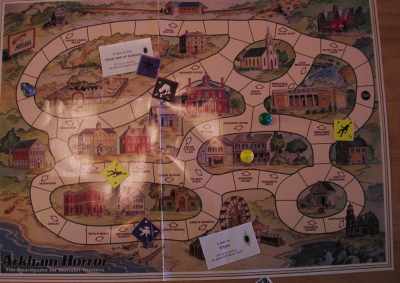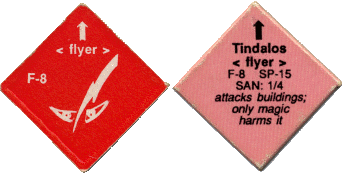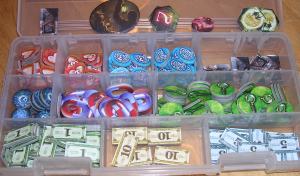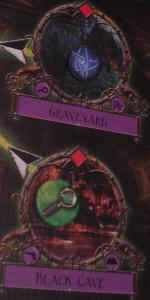
The portion of the board depicting Arkham. (Larger image.)
Fantasy Flight Games has brought Arkham Horror back into production with a new 2005 edition. In the game players cooperate to defend the city of Arkham against an extra-dimensional invasion of Lovecraftian horrors. Chaosium's original 1987 edition featured simple silhouette graphics and muted design. Fantasy Flight's 2005 edition overhauled the game and added pervasive gorgeous art.
Although the 2005 version has been overhauled, the core gameplay is the same. Players select from a variety of characters: professors, archaeologists, debutantes, and other archetypes from Lovecraftian fiction. These characters dwell in the town of Arkham, a city about to be invaded by otherworldly beings. Supernatural gates to other worlds open throughout the game. From these gates emerge strange monsters and their human followers. These monsters wander the streets and threaten the characters. The characters must make their way to the gates, evading or battling the monsters and their human minions. The characters then must travel through the gates, explore the other planes of existence, then return to close the gate. If the character close enough gates the otherworldly threat is foiled, the world is saved and the players win. If too many gates open or the characters take too long the other worlds break through to our world. Some horrible and Lovecraftian horror comes through and destroys the town and probably humanity. The players lose. While rules exist for determining which of the players was most effective and is thus the winner, the focus is on cooperative play. The risk of group failure means teamwork is key. The game features no real mechanism for working against fellow players; the worst you can do is fail to be helpful.
This is a difficult game. I've played several games and have never won. My girlfriend's family has played several dozen times and remembers winning once. There are several ways for a character to die permanently, forcing the player to restart with a new character. Perhaps more importantly, the only way for players to win is to end a turn with no open gates on the board. As a new gate appears every turn and it takes several turns for a gate to be closed, this requires coordination on the part of the players and no small amount of luck. The approximately 13 turn time limit tends to run out before players can seal all of the gates simultaneously. It's nice to be challenged, but it's easy to feel frustrated.
At it's core Arkham Horror 1987 has the core of a good game. Each turn you plan with the other players on how best to divide up the gates as they open. You try to avoid the monsters prowling Arkham, perhaps assigning a particularlly well equipped character battle some of them. You travel to other planes of reality, hoping to survive and return to seal the gate and protect Arkham just a little longer. The juggling is fun. If anything, the game needs to give players more of a sense of control.
Visually the game is unimpressive. It's a small market "gamer game" from the eighties and it looks it. The board is printed on light cardstock. The board is full color lined art. The art is simple and clean but fails to be evocative. The board is visually dominated by off-white roads divided into spaces. The other planes are represented by small graphics. The monster chits have a simple silhouette of the monster on one side and statistics on the other. The character cards are printed in full color, but the color is only used to indicate which of the pawns represents the character; the illustration of the character is black and white. The characters have a name and an illustration, but no other description. Helpfully, the character's range of Strength Points and Sanity Points are along the edge, designed to be easily easily marked with provided paperclips. The paperclip markers work well; bumping the character card doesn't disrupt the markings.
The game is reasonably simple. Each turn a new gate and monster appear at random on the board. Characters have four static statistics (Fast Talk, Fight, Knowledge, and Sneak) and two that vary (Strength (life) Points and Sanity Points). Players roll dice to determine how far they move across the board. Monsters generally move about Arkham's looping streets in simple patterns. Characters who cannot avoid monsters may try to sneak by or kill the monster. If a character arrives at a location, they may roll on a table in "the ARKHAM GAZETTE" booklet to see what happens. Skill challenges are done by rolling a single six-sided die. If the result is lower than the skill, the character succeeded. Combat with monsters involves rolling a single die, adding the appropriate skill and any modifiers from equipment like weapons, and comparing it to the monster's "Strength Point" rating. If the result is larger than the monster's rating, the monster is defeated. If the rules is lower, the character takes one die's worth of Strength damage.
While the game is generally simple, the rules are confusing. The rules themselves are split between two booklets, the rules proper and the "about YOUR INVESTIGATOR" sheet. It's not entirely clear why any given rule is in a particular booklet. The booklets have few examples. As a result, it can be difficult to learn the game.
The monsters themselves are heavily coded. Once learned they are reasonably succinct, but they are a bit daunting. For example, one monster token's front and back read:

This particular monster, the Tindalos, flies (this special form of movement is documented in the rules), it moves 8 spaces each turn, is has 15 Strength Points, it does 1 or 4 points of sanity damage depending on a character's check, it can attack characters in buildings (most monsters are limited to the city streets), and physical attacks are ineffective. Given the limited space, the monster is simply labeled "Tindalos" while the creature is generally known in Lovecraftian fictions as a "Hound of Tindalos".
While there are a fair number of different monsters and special rules, in general they don't feel very different. In general only the Strength Points matter. It doesn't matter if the character encounters a Flying Polyp or great Cthulhu himself, the difficulty of making the sanity check is the same and the resulting mental damage is similar. The silhouette art is visually interesting and distinct, but fails to evoke monsters with which players are not familiar.
One nice touch is that the game ships with paper play money. The money feels real and significant. Oddly enough, money has little impact in typical game play, mostly being used to pay for taxis to speed movement.
All in all, a satisfying game, but age has not been kind to it. It's easy to be distracted by the simple visual design. It's hard to feel drawn in by the characters and the setting. It's hard to be creeped out by the monsters. Given the difficulty of the game, it's easy to feel frustrated.
It's clear that the designers of the 2005 edition carefully reviewed the original version for its strengths and weaknesses. Most of the weaker parts of the 1987 edition have been fixed or simply removed. The strengths generally remain or were polished even further. Unfortunately, a number of vexing new weaknesses were added to the 2005 edition. The game is great fun, but the flaws keep it from rising above very good and into the brilliant, timeless game it could have been.
The 2005 edition is simply more fun than the 1987 edition. Players have more options and more choices to make. The new edition gives the players a better chance of winning, making the cooperation between players feel meaningful. The evocative graphic design helps draw one in and get a sense of the horrors your characters face. It's fun to struggle against those horrors and strive to save Arkham.
The 2005 edition of Arkham Horror is much easier than the 1987 edition. I've played 5 or so games and the players have yet to fail, although our group occasionally only barely won. It is almost impossible for a character to die permanently. While players can win by sealing all gates simultaneously, a new victory condition is added. A character can collect Clue tokens as they explore the town. Clue tokens can be spend to improve rolls, but more importantly a character can sacrifice five clue tokens to seal a gate permanently. Once sealed permanently, a gate can never reopen in that location. As locations are sealed, gates appear less and less frequently as they are blocked by seals. Once enough locations are sealed, the players win.
Challenges are more complex, but are now more consistent. A player rolls a number of dice equal to his skill plus any bonuses for equipment or other effects. The number of dice may be reduced or increased based on the difficulty of the encounter. When rolling a 5 or 6 is a success. Most challenges require only a single success, but some require two or more.
Clues are an important addition to the game. Instead of wandering around aimlessly trying to become more powerful before facing monsters, it feels like the characters are actually investigating the situation. Their investigations pay off in knowledge about specific monsters and problems, giving them an advantage.
Beyond being easier, the most obvious change is the look. Instead of occasional simple illustrations, the 2005 edition is lavishly illustrated with full color, photorealistic art. The character portraits on the character cards are excellent, giving a real sense of a human being. The monsters are similarly well illustrated. You really see what a Hound of Tindalos looks like. The cards are filled with more original, photorealistic art. The board is larger and mounted on a standard thick cardboard. While not quite as compelling as the other illustrations, the board does look convincingly like an aerial photograph of a city. Unfortunately the game locations and streets don't align well with the city, leaving the gameplay feeling disjoined from the city itself.

The next most obvious different is how much stuff the game comes with. The 1987 edition came with 7 decks of cards, character cards, 1 set of tokens, and play money. The 2005 edition comes with 13 decks of cards, character cards, Ancient One cards, 13 different types of tokens (including the money tokens). You'll want to invest in a small tackle box to sort things out in.
Given all of these decks, tokens, character cards, and the large board, you'll need a large play area. It is difficult to cram 6 players around my 3 foot by 5 foot kitchen table. Cards and characters were frequently jostled, disrupting important information.
Characters are more complicated in the 2005 edition, generally for the better. There are more characters (16 options), and each comes with an interesting back story printed on the back of their card. Instead of pawns, each character has a smaller version of their artwork that fits in a provided stand. Characters have 8 statistics. Characters also begin with varying equipment, money, and skills. Most have special abilities. For example, the doctor can heal himself while the nun begins the game with the the Blessed attribute. The result is far more interesting and distinct characters.
Three pairs of the characters attributes are linked. Raising one linked attribute lowers the other. The ranges for each set vary from character to character. Each turn a character can adjust a number of his attributes, allowing a character to slowly prepare themselves for expected problems. While adding a fun mechanic, this adds complexity to tracking. Because Sanity and Strength change so frequently, they are represented with tokens you gain and lose as your character is healed and injured. The other attributes are marked with oval markers that cover the two related attributes. This generally works, but if the character card is bumped on the crowded table, it's possible for one's attribute markers to end up in disarray.
An interesting addition is the idea that a specific Ancient One is trying to break through to the mortal world. At the beginning of the game you select one of the Ancient One cards at random. Depending on which ancient one is trying to break through, there is a minor change to the game play. For example, if Ithaqua, the Arctic Ancient One, is trying to invade, there is a constant ice storm. The ice storm damages characters who end their turns outdoors.
The 2005 edition adds an ends game should the characters fail to seal the gates quickly enough. The character engage in a last stand effort against the Ancient One itself. The Ancient One is powerful and the characters are likely doomed, but it does an an interesting last chance to try using risky magical items and snatch victory from the jaws of defeat.
Another notable change is that the board itself has been simplified. Instead of rolling dice and moving space to space, the city has been simplified into a small number of outdoor spaces. Characters simply move a constant number of spaces based on their Speed attribute. The resulting design means that more of the aerial view of the city is visible and paths don't dominate the board.

Setup in much slower than the original game. The decks are intended to be shuffled during game play, but during set up you need to extract assigned equipment from the common equipment and unique equipment decks. Depending on which ancient one has been selected, you may need to remove a subset of the monster tokens from play.
The game is beautiful to look at, but in many cases beauty has been selected over usability. Each neighborhood in the city has its own deck of about 10 cards. However, there is no good place on the board to put these decks next to their associated neighborhoods. The rules suggest putting them to the side of the board. Unfortunately the decks aren't labeled with the name of the neighborhood they are associated the. The decks are colored, as are the neighborhoods, but the colors don't precisely match. Add difficulty discerning similar colors in low light or with color blindness and you run into problems.
An improvement to the board over the original rules is markings indicating likely beneficial effects to be found at a given location. This means you can quickly scan the board looking for places that might give you unique items instead of skimming the many tables in the previous edition.

The full color board and markers tend to blend into each other. In particular the elder sign and clue tokens tend to disappear into the colors of the board. Similarly, the character portraits are so detailed and subtle that it is difficult to scan the small character markers on the board for your own piece.
Once you're playing, you face the raw complexity of the game. In play you'll need to track any special rules your character must follow each turn, any global environmental conditions added by cards, any local conditions ("rumors") associated with particular neighborhoods, and the special rules associated with the ancient one in play. In practice our group found ourselves frequently overlooking some special circumstantial modifier.
Play in broken into phases during which players take actions. All players move their characters and encounter monsters in turn, then players with characters in Arkham resolve their events in turn, then players with characters in other worlds resolve their events in turn. Interleaving the player's turns this way is disruptive and unexpected.
The many, many decks don't have text labels, instead they have cryptic symbols. After several games our group is only beginning to remember them. For example, a gun doesn't represent a "weapons" deck, it's the "common items" deck. The Elder sign deck isn't "unnatural things", it's "unique items". A scroll isn't "spells" (that's the book), it's "skills."
Each turn a Mythos card is drawn. This card is packed with information. It may add a condition to some or all of the board. It may have a one time effect. It also indicates where a gate opens, and which monsters move. Monster movement is indicated as a series of abstract symbols. Those monsters which have that symbol move along the colored arrow (black or white). Adding to the complexity is that each monster has a colored border; indicating which special movement rules it follows. The table of special movement rules is present only in the center of the rules. Each turn players much scan the board for monsters with the appropriate symbols, cross reference the monster's border colors with the rules, then move the monsters in accordance with the rules.
Instead of a booklet of tables for encounters in Arkham locations and the outer worlds, Fantasy Flight has added decks of cards. There is a deck for each neighborhood in Arkham and each neighborhood has three locations. When you visit a location you draw from the appropriate deck. The card will have three entries, one for each possible location. You'll follow the instructions on the one location. You then shuffle the deck. Given that the decks have only 10 or so cards each, it's difficult to shuffle them well. In practice this doesn't seem easier than rolling a die and checking a table in the booklet.
For the outer worlds, there is a single deck. Each outer world is marked with two or four colors. You pull cards from the deck until you find one with the matching color. You then read the entry marked for the outer world your character is in. If your outer world isn't specifically named, you read the entry marked "Other." It's not uncommon to draw four or five cards looking for an appropriate one. It's decidedly more work than looking up results on a table.
Ultimately the 2005 edition of Arkham Horror is a much more complex game. While the rules are more clearly written and feature useful examples, the added complexity has caused our group to overlook a number of rules. Each game we play is different as we discover yet another overlooked but important rule.

Arkham Horror's inconsistencies add to the complexity. Challenges written on cards are listed in the form -2[2], meaning roll 2 dice less than normal, and you need 2 successes. On monsters the modifier to the number of dice is in the lower right of the token. Immediately below that is one or more hearts; however this isn't how many successes the character needs. Instead it's the damage the character takes if they fail. Instead the number of successes needed are shown as a number of blood drops in the middle bottom of the card.
Other inconsistencies include differing place names. The board identifies one of the outer worlds simply as "Celeano," while gates to the world list it as "Great Hall of Celeano."
The board has several confusing locations. Along the edge of the board are three special locations. One is "The Sky" and is reserved for flying monsters. One is "Lost in Time and Space" and is reserved for characters who run out of sanity or strength in another world. The last is "Outskirts of Town" which is a sort of monster counter.
Indeed, the monster counter is important because the number of monsters on the board is limited by the number of players. Extra monsters that should be added instead are placed in the outskirts of town. The 2005 edition has added a "terror level" to the game. As it rises some businesses close and ally cards are discarded. A variety of effects raise the terror level. For example, when the Outskirts of Town containing a certain number number of monsters, the monsters are returned to the pool of available monsters, the terror level is raised, and the process restarts.
While the cards look very nice, they are also very stiff. It can be difficult to shuffle the larger decks. Perhaps with some more play they will less stiff.
Money is represented with small cardboard tokens. The money doesn't evoke money, feeling too much like an abstract token. Like the 1987 edition of Arkham Horror, money doesn't have much impact in the game.
The stands for placing the character markers are very snug. Once inserted the markers are very stable, but that same tight fit means that it's easy to scratch the art on the markers as you insert them. A pair of thin pliers helped us minimize the damage.
All in all, the 2005 edition of Arkham Horror a very satisfying game. It's fun to wander the city, find clues, enhance your character, and fight to save the world. The new rules add fun options and details to consider for players. However the resulting game is very complex. You'll spent a great deal of time looking up rules and checking many possible rules modifiers in play at any given moment. The result is fun, but flawed. The 2005 edition of Arkham Horror comes so close to being exceptional that it's frustrating that it's only very good.
(Updated 2005-09-24: Added some notes on the good parts of the games. Added details on the end game in the 2005 edition.)
(Updated 2007-01-08: Fans of Arkham Horror and original series Star Trek might find this inspirational poster funny. From Star Trek Inspirational Posters.)
This page can be discussed over in my comments. There are currently comments.